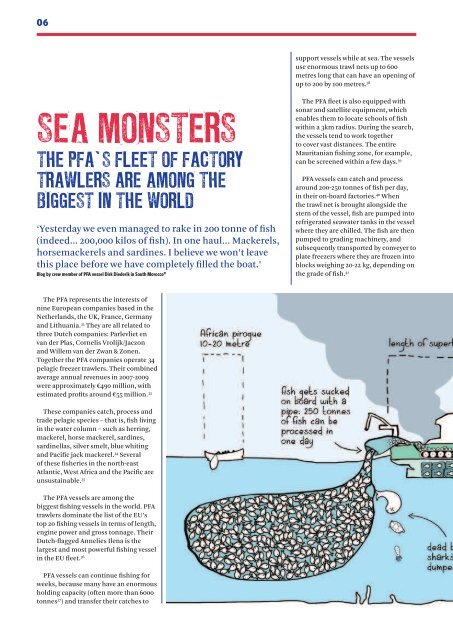THE PRICE OF PLUNDER - Greenpeace Nederland
THE PRICE OF PLUNDER - Greenpeace Nederland
THE PRICE OF PLUNDER - Greenpeace Nederland
Create successful ePaper yourself
Turn your PDF publications into a flip-book with our unique Google optimized e-Paper software.
06 07<br />
SEA MONSTERS<br />
<strong>THE</strong> PFA’S FLEET <strong>OF</strong> FACTORY<br />
TRAWLERS ARE AMONG <strong>THE</strong><br />
BIGGEST IN <strong>THE</strong> WORLD<br />
‘Yesterday we even managed to rake in 200 tonne of fish<br />
(indeed... 200,000 kilos of fish). In one haul… Mackerels,<br />
horsemackerels and sardines. I believe we won’t leave<br />
this place before we have completely filled the boat.’<br />
Blog by crew member of PFA vessel Dirk Diederik in South Morocco 31<br />
support vessels while at sea. The vessels<br />
use enormous trawl nets up to 600<br />
metres long that can have an opening of<br />
up to 200 by 100 metres. 38<br />
The PFA fleet is also equipped with<br />
sonar and satellite equipment, which<br />
enables them to locate schools of fish<br />
within a 3km radius. During the search,<br />
the vessels tend to work together<br />
to cover vast distances. The entire<br />
Mauritanian fishing zone, for example,<br />
can be screened within a few days. 39<br />
PFA vessels can catch and process<br />
around 200-250 tonnes of fish per day,<br />
in their on-board factories. 40 When<br />
the trawl net is brought alongside the<br />
stern of the vessel, fish are pumped into<br />
refrigerated seawater tanks in the vessel<br />
where they are chilled. The fish are then<br />
pumped to grading machinery, and<br />
subsequently transported by conveyer to<br />
plate freezers where they are frozen into<br />
blocks weighing 20-22 kg, depending on<br />
the grade of fish. 41<br />
MEASURING CAPACITY<br />
Fishing capacity essentially describes<br />
the ability of a fishing vessel or fleet of<br />
vessels to catch fish. The main factors<br />
affecting fishing capacity are:<br />
• vessel characteristics, such as<br />
the tonnage and overall holding<br />
capacity, engine power, freezing<br />
capacity etc;<br />
• fishing gear characteristics,<br />
generally considered in two groups –<br />
active gears, in particular trawl nets,<br />
and passive gears, such as gill nets<br />
and pots;<br />
• operational characteristics, such<br />
as distance to fishing grounds,<br />
available fish-finding technology<br />
such as sonar, the price of fuel,<br />
biology of the species and even the<br />
experience of the crew.<br />
©GP/Staats<br />
Consequently, the measurement<br />
of true fishing capacity is a complex<br />
calculation, combining technical<br />
characteristics alongside economic<br />
and biological factors. Therefore, gross<br />
tonnage and engine power are often<br />
used as a rough indicator of fishing<br />
capacity. Another important factor<br />
influencing how much a fishing vessel<br />
can catch is the time it spends fishing<br />
or the number of hooks and size of<br />
nets it uses – the so-called fishing<br />
effort. To get a full picture of the<br />
potential impact of a fishing fleet on<br />
the resource, one should therefore<br />
take into account the multiple<br />
factors affecting real fishing capacity,<br />
combined with fishing effort and the<br />
number of vessels employed. Last but<br />
not least, it is necessary to consider<br />
the specific characteristics of the<br />
ecosystem and its fragility.<br />
The PFA represents the interests of<br />
nine European companies based in the<br />
Netherlands, the UK, France, Germany<br />
and Lithuania. 32 They are all related to<br />
three Dutch companies: Parlevliet en<br />
van der Plas, Cornelis Vrolijk/Jaczon<br />
and Willem van der Zwan & Zonen.<br />
Together the PFA companies operate 34<br />
pelagic freezer trawlers. Their combined<br />
average annual revenues in 2007-2009<br />
were approximately €490 million, with<br />
estimated profits around €55 million. 33<br />
These companies catch, process and<br />
trade pelagic species – that is, fish living<br />
in the water column – such as herring,<br />
mackerel, horse mackerel, sardines,<br />
sardinellas, silver smelt, blue whiting<br />
and Pacific jack mackerel. 34 Several<br />
of these fisheries in the north-east<br />
Atlantic, West Africa and the Pacific are<br />
unsustainable. 35<br />
The PFA vessels are among the<br />
biggest fishing vessels in the world. PFA<br />
trawlers dominate the list of the EU’s<br />
top 20 fishing vessels in terms of length,<br />
engine power and gross tonnage. Their<br />
Dutch-flagged Annelies Ilena is the<br />
largest and most powerful fishing vessel<br />
in the EU fleet. 36<br />
PFA vessels can continue fishing for<br />
weeks, because many have an enormous<br />
holding capacity (often more than 6000<br />
tonnes 37 ) and transfer their catches to

















